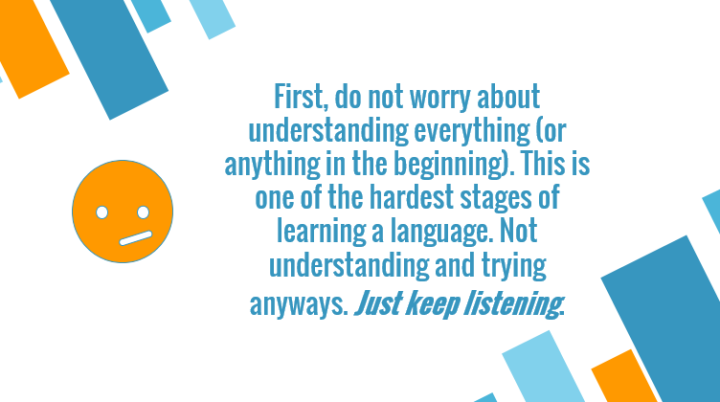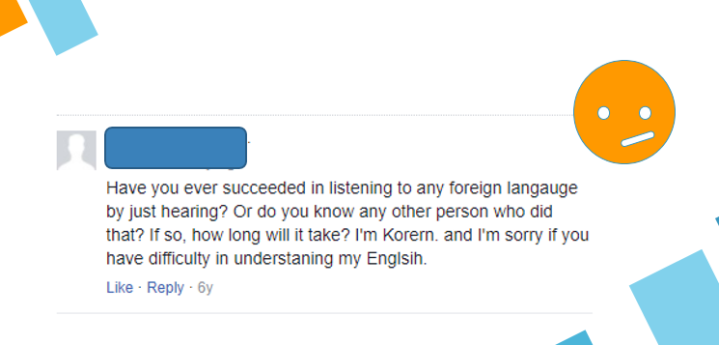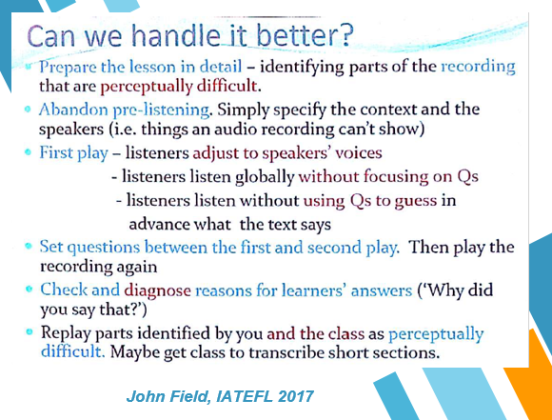IH BCN ELT Conference 2018
Almost, but not quite a month has passed since the IH Barcelona 2018 conference – time enough for various work and life priorities to bump this talk write-up further down the to-do list. As in previous years, it was a fun event with many thought-provoking talks and workshops. For a broad view of what went on, Chia Suan Chong, one of Saturday’s plenary speakers has a handy write-up for the ETP blog over here. The IATEFL Learning Technologies SIG have also posted a write-up of the 5 LTSIG sessions here.
As for my own talk – it was focussed on developing listening skills. Talks need titles, as we all know, and so a quick google of idioms with the word ‘listen’ in them was my starting point when preparing. I needed something punchy that would at once grab people’s attention and summarise the essential themes of the talk. My googling yielded a number of unsuitable candidates which were swiftly rejected. People wouldn’t listen up, they’d listen with only half an ear, in fact, the whole thing would likely fall on deaf ears, it’d be like talking to a brick wall – nobody would take any heed of a single thing I was saying.
I stumbled across a conference title generator online. You can try it out here. It gave me: Rhetorical Agency in the listening skills of Visual Culture, which didn’t quite hit the mark either.

So in the end, it was Robert Mathew Van Winkle – nom de plume, ‘Vanilla Ice’, famed wordsmith and renaissance man, whose punchy ‘stop, collaborate and listen’ provided the necessary title from which all other parts of the talk would flow.
After all, the talk was about listening – we’d stop and think if commonly adopted approaches to listening are helpful for learners, and we’d share some material developed collaboratively. It made perfect sense. More sense, at least than the rest of Ice’s song. (Where was he back from – this was his first hit? How exactly does a harpoon flow? Why is he sending word to my mother?? So many questions…)
I’ve taken the liberty of adding the original video here, in case you need reminding of or perhaps introducing to its catchy genius:
So, anyway… back to the talk itself.
John Field had given the opening plenary of the conference on Friday, and I was hoping to share some practical classroom applications of the research findings he presented.
STOP!
Putting an imperative ‘stop’ into a presentation could be seen as somewhat dogmatic, so I decided to clarify why from the outset – for me, this ‘stop’ is about pausing to think rather than barking out commands. I work as a teacher and teacher trainer, I think it’s useful every now and then to stop and to question the procedures I use, the techniques, the lessons and training sessions and ask ‘is this helpful?’. Both language learners and teachers are on the lookout for techniques and approaches which can help them in their development. In terms of listening, students of mine often come up after class and ask for advice on how they can improve specific aspects of their language. When it comes to listening, the advice is very often do more of it: ‘just practice’, ‘Watch TV in English’, ‘Watch a movie in English’, ‘Listen to the radio’, ‘Listen to podcasts’ etc. While there’s a very good common-sense argument for increasing the amount of time students spend doing something in order to get better at it, the time-on-task principle can be criticized for emphasizing quantity over quality, as Paul Nation readily concedes when justifying his four-strands approach to achieving balance in a language curriculum. Just doing more of something doesn’t necessarily make you better at it. It may be necessary, but it certainly isn’t sufficient.

The kind of advice that can be readily found to help learners improve their listening ability (and by extension their language learning ability) is often exactly this – ‘just keep listening’. The implication is that this will all somehow magically sink in and you’ll get better with little effort. Such advice isn’t really helpful – and even the learners themselves know this – here’s a reply from a skeptical learner to the original post. Their skepticism is well-placed.

The above was posted 6 years ago. At the time of writing there was no reply.
At the same time as telling people to listen more, there’s the oft-invoked exhortation not to worry. In our rush not to upset our students – or raise affective filters if you prefer – we often attempt to cushion them so much that very little learning or language development can take place in a lesson. The original post above advises ‘don’t worry about understanding everything’ – and this is a phrase I’ve heard many a time (I used to use it myself a great deal) and it doesn’t really help anybody get any better at understanding anything. Of course, I’m not suggesting we all turn into caricatures of evil schoolmasters from a sub-Dickensian period piece, but rather that it might not be a bad idea to admit that what we do in a class is challenging, that we should worry, but that we’ll be able to improve through hard work by the end of a lesson / sequence of lessons.
How can we do this?
Firstly, by focussing a lot more on the substance of the speech stream and decoding, especially, but not exclusively at lower levels. Learners up to B1 are so focussed on segmenting and extracting words from the audio signal and matching these on to their mental lexicon that they have little time for ‘higher’ level processes such as inference of unstated facts, inferring speaker viewpoint and so on.
A simple way of doing this is to pause a recording at perceptually difficult parts and have listeners transcribe what they hear. You could do this on the board, using a simple proforma (like this) or by creating a gapfill from the transcript.
In the talk we looked at 3 possible gapfills to use with the following video:
It’s definitely a challenging text – I’ve used it with B2ish and up. And just the first 40 seconds for close perceptual work – the rest either as homework or pre-class ‘flipped’ input. At the stage of the lesson where the gapfill comes in, we’ve already listened to the video a few times and established the situation and many of the details. Depending on the class size, this is done as a whole group or in pairs/threes with me prompting by asking questions such as ‘what are they talking about?’ ‘How much did you get?’. The questions might be about details in the recording – e.g. ‘when was this?’.
Since a lot of these activities are based on a criticism of the comprehension approach, some people have asked me ‘is that allowed? I though questions were banned!’ – to which my response is ‘yes!’ – the difference here is when the questions are asked how and for what purpose. In summary, then, comprehension questions can be utilised:
When: after at least one listening with no questions set.
How: possibly just orally – keeping to the spoken mode, and not always confirming answers.
Why: to gauge how much the learners understood, why and where they didn’t understand so that you can focus on specific parts of the recording afterwards. More of a diagnostic approach than validating correct answers shouted out/written down.
The procedure for the lesson follows very much that advocated by Field. Here’s a slide stolen from his IATEFL 2017 presentation, but also easily extractable from Listening in the Language Classroom.

So, bearing that in mind, we looked at three different gapfill tasks and decided which would be best for this final part focussing on perceptual difficulties. [I’ve done a similar thing with a different video elsewhere – see here for another example.]
Here they are: which would you use?
This lovely gapfill?

This one?

…or this one?

The one I used was the last one. The other two are focussed on either detail(s) [gapfill 2] or lexis [gapfill 1]. These are important things to focus on, but not my focus for this stage of the lesson. The third gapfill looks at parts of the recording featuring words my students know, but which are pronounced in surprising ways (the usual suspects being elision, catenation, assimilation).
Where the students find it difficult to write down the missing words, we can stop, pause, replay and read ourselves from the tapescript (with natural linking but slowing down and speeding up our voices like human taperecorders!). One advantage of using a apped tapescript is that the teacher can focus on areas likely to come up again frequently in later listening – e.g. the last gap above ‘a whole lot of’ has caused many problems for learners up to C1 level for me and appeared in previous and later lessons as an issue in chunks like ‘a lot of’ ‘an awful lot of’ ‘a load of’ ‘a portion of’ etc. Such phrases can be embedded into later microlistening/dictation activities for further practice.
Once the script is complete, it’s worth playing a final time to give a chance to ‘hear’ the words once more in context. This is important for motivation and often leads to a nodding ‘now I can hear it’ appreciation. Of course that won’t always happen, which is why it’s important to return to exercises like this over a series of classes. It also serves as a model to those students who want to practise outside of class but don’t know how to beyond the ‘just listen more’ approach outlined earlier. With an interesting video and a tapescript, they can follow a very similar procedure themselves.
Collaborate.
Collaborating with other teachers is a good way of increasing the interest in this area, and reducing your own workload. To this end, as I’ve described before, I set up a Facebook group where teachers (often me, sometimes 30 minutes before a class!) can request soundbites from each other on current topical events. For example, with the detox video posted above, two kind contributors (so far) gave their own views on detoxing. I’ve used these in follow-up homework for some groups, jigsaw listening on mobile devices for another, or just playing straight off my mobile in a one-to-one setting. The fact that these are real people from various parts of the world has often added a level of motivation for the students.
This is building up into a nice crowd-sourced library of short unscripted audio texts and (sometimes) tapescripts which can be used by anyone however they see fit. It’s also had the added advantage of allowing a space to reflect on difficulties our students have with listening and how we as teachers approach it.
If you’d like to join, the group is here. Anything you post can be used by others in the group and you can put in requests for audio responses on anything you may be focussed on in your classes.
That was about it for the talk, and I’ve got a class to dash off to now. In the words of Vanilla Ice, then:
Yo man, let’s get out of here
Word to your mother.


This looks like it was a great talk. I bet you were cooking MCs like a pound of bacon. I am also almost tempted back to Facebook by your group’s existence.
LikeLike
Thanks Marc, it went OK, I thought. The write up doesn’t quite convey the tongue-tied rambling around minute 7.5 – I doubt I would have cooked many MCs 8-mile style.
As for the Facebook group – I did wonder about the platform for that – I’d originally envisaged this blog as a possible kind of swapshop / network / curated materials bank, but it just doesn’t have the immediacy. Hence the Facebook group. I know fb isn’t everyone’s cup of tea and it can be a drain on the old time resources. Why not set up a new profile under a pseudonym and try it out for a couple of weeks? You’d be most welcome, and it’d be good to get members from further afield geographically. If not, would you suggest a different platform?
LikeLiked by 1 person
Thanks Shaun. I dunno about another venue than Facebook, either to be honest because Slack isn’t other people’s cup of tea either, nor is Google Plus. Hmm. Pondering!
LikeLiked by 1 person
Not that everything isn’t great, but it never occurred to me before to get soundbites from other teachers to build into a library. So simple, yet so clever! 🙂
LikeLike
Thanks, Tyson. It is indeed, very simple. My own focus is often listening, but as a library of texts it’s easily exploitable for a range of language learning purposes.
LikeLike